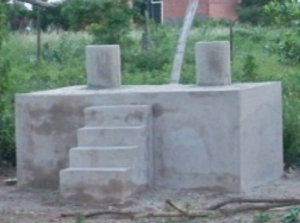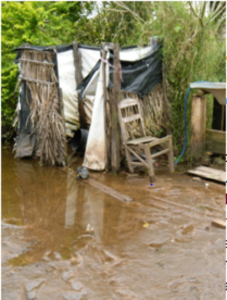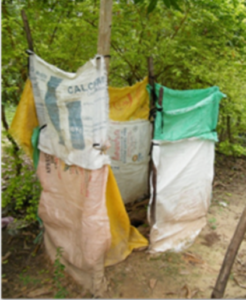Etta Project’s Dry Composting Toilet

The three goals of the program include:
- Construction of the dry latrines, working together with the families and our team of experienced builders.
- Train community members (children/students, teachers, community leaders and families) on hygiene and sanitation, to effect behavior change and increase the quality of health. Topics include: disease prevention, hand-washing, food preparation and consumption, trash separation/composting, safe water practices, and proper use and maintenance of the dry latrines.
- Train local sanitation promoters to monitor each dry latrine in their community, using checklists and charts that are posted in each latrine. The family is rated (using a color coded chart) on each task. Promoters share information and methods for how to improve hygiene and sanitation, and proper latrine use.
- Monitor the project with a behavior-based system, and use this information to improve current and future projects.
The Model: The ecological dry composting latrine is a simple, low-cost sanitation facility built using locally available materials.
The latrines are above ground and do not require water or complex plumbing. The latrine is built on a double vault system, with one chamber in use at any given time. A toilet is designed with two holes which allows for separation of urine from fecal matter. Fecal matter enters the disposal chamber where it is contained and decomposes; urine is captured separately. When this chamber is full, the toilet is moved to the second chamber and fecal matter in the first chamber begins the composting process. After each use of the latrine, dry material (ash, lime, rice husk, sawdust, or dry dirt) is added to prevent odor, repel bugs, and start decomposition.  Used toilet paper is thrown into the latrine and will not disrupt decomposition. The process of filling one chamber, closing it off and switching the toilet bowl to the other chamber, and excavating compost must be maintained for the toilet to function properly. This model eliminates risk of fecal matter leaking into ground water, produces fertilizer, and conserves water.
Used toilet paper is thrown into the latrine and will not disrupt decomposition. The process of filling one chamber, closing it off and switching the toilet bowl to the other chamber, and excavating compost must be maintained for the toilet to function properly. This model eliminates risk of fecal matter leaking into ground water, produces fertilizer, and conserves water.
The dry latrine MUST remain dry! No water or urine can enter the chamber. Urine is diverted through a pipe connected to the toilet bowl. The pipe is either buried in the ground, where it travels through a gravel and sand filter, or the pipe connects to a 10 gallon container, where urine is collected to use as fertilizer or insecticide.


Benefits of the dry composting latrine:
- Hot tropical humid climate aids in decomposition of fecal matter
- Region prone to flooding during the rainy season, causing pit latrines to overflow and contaminate yards and public spaces. Dry latrine has sealed, above ground vault that prevents waste from escaping.
- Typical pit latrines contaminate drinking water (high water table/shallow ground water level in region). Dry latrines contain fecal material in concrete chambers.
- Produces rich fertilizer (solid and liquid) for crops
- Conserves water (many local communities lack access to water)
- Provides an above ground “hut” for privacy and safety (free of dogs, snakes, and vermin. Women, children, and men are exposed to these dangers with pit latrines and open defecation).

Typical pit latrine during rainy season

Dry composting latrine
Community Training
Etta Projects program coordinators organize community workshops to raise public awareness about the consequences of poor sanitation as well as to organize and motivate villagers to change their current sanitation situation. Community meetings include sanitation mapping exercises, and the discussion of sanitation and health topics: water related illnesses, the dangers of excrement, options to improve sanitation, and benefits of the ecological latrine model.
Villagers elect sanitation promoters to serve their community. EP trains sanitation promoters to support the participating families to correctly use and maintain their ecological latrines as well as promote additional healthy hygiene habits. Having promoters work directly with families enhances project sustainability through local knowledge. The promoters, who live in the community, are known, present, and consistently involved with dry latrine monitoring.
The sanitation promoters make home visits to evaluate the dry latrines on the following factors:
- Does the latrine have a door/curtain (family’s responsibility)
- Is the toilet seat covered with lid
- Are there dry materials available inside the latrine
- Is the latrine free of odor and/or insects
- Is the latrine clean inside and out
- Is there a stick for stirring the fecal material in the chamber, and is it being used once a week
- Is there a hand washing station within 15 paces of the latrine
- Are family members washing their hands after every use

Sanitation promoters teach composting in the school
Each indicator is measured by a point system. A total of 22-24 points indicates optimal usage, 18-21 points is acceptable usage and any score below 17 needs improvement.
EP organizes workshops for school children in the community. Topics include:
- Disease prevention
- Proper Hand Washing Practices
- Water conservation
- Use & Maintenance of Ecological Latrines
- Trash separation and composting
Construction Process: Families involved in each stage, including:
- Selecting the Location of Latrine

Elena learns how to cement her chamber door. After learning how to mix cement she made 3 grey water filters in her house.
- Forming & Pouring Slab for Lower Foundation
- Forming and Pouring Slab for Upper Foundation
- Construction of Chambers
- Building the Sub-Floor
- Building Walls & Roof
Family testimony reflects the impact of the project on their lives.
One five-year old child stated “I am not scared of going to the bathroom anymore“. A 72-year old woman shared, “Never in my life have I used a bathroom so clean.” Romana from La Patria said, “We use our new bathroom every day. I take out the toilet seat and wash it with bleach to make certain it is clean.” Mary Sanchez, from La Patria, adds “I am very happy with my latrine. When it rains, we really see the change this project has brought. We no longer have to go outside in dirty, wet pit latrines. I clean the toilet and make certain it has dry material. I want to maintain it well, so that it will last a long time.”

Before

After

